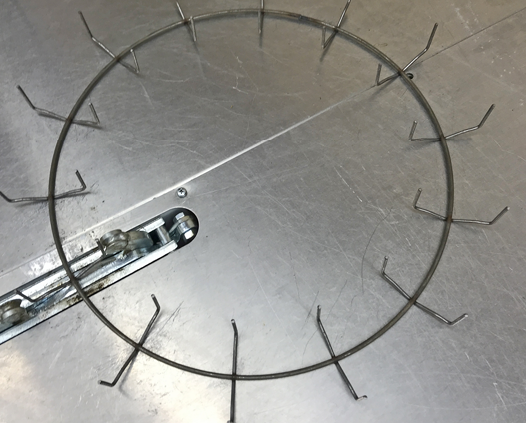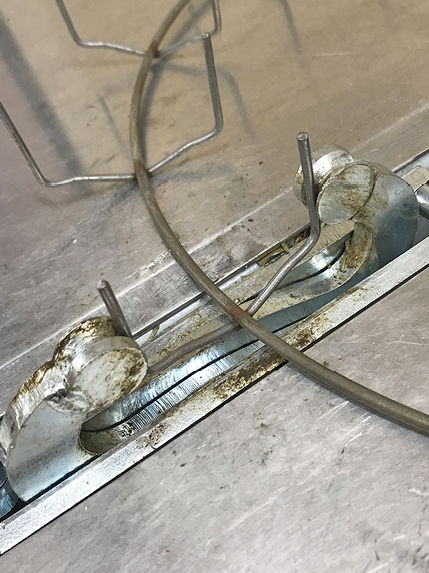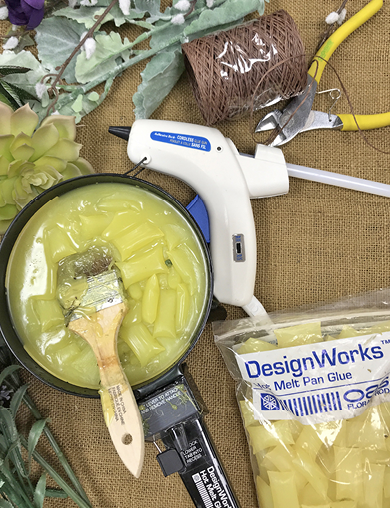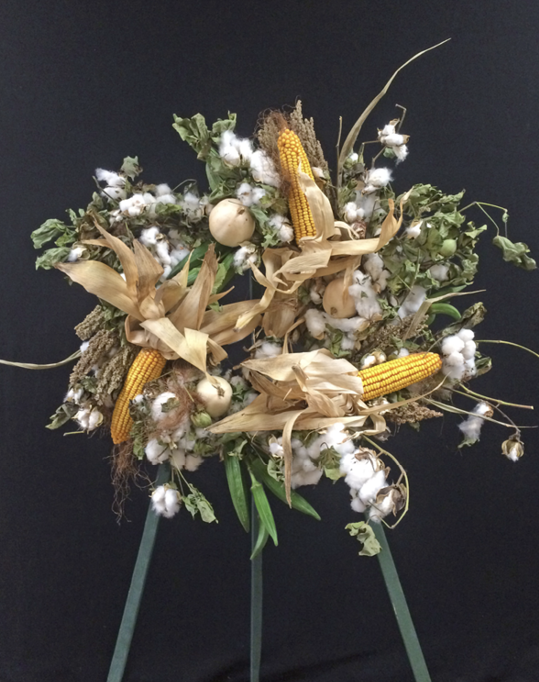Row Crop Wreath for the Farmer Florist
The bounty of agronomic crops grown in Mississippi is important to our country’s agricultural output and is also symbolic of our state. Many consumers are interested in decorating their homes and businesses with adornments that exude abundance and plenty in the fall season. In this publication, you will learn to construct a wreath using okra (Abelmoschus esculentus), squash and pumpkin (Cucurbita pepo), cotton (Gossypium hirsutum), milo (Sorghum bicolor), and corn (Zea mays).
Harvest and Handling
Fully air-dry okra, cotton, and milo before using in this design. Place these materials in a dry place that is free of rodent and insect pests. Place stems upright in a clean, dry container to prevent flattening or damage. Remove corn ears from stalks and place them on a clean, flat surface to dry. Pumpkins will continue to cure after harvest. Keep them away from excessive heat and humidity.
Cultivar Recommendations
Okra
- Rainbow Fiesta (blend of red, orange, white, and green)
- Carmine Splendor (dark red)
- Burgundy (maroon)
- Jing Orange (dark orange-red)
Pumpkin
- Snowball (white)
- Casperita (white)
- Wee-B-Little (orange)
- Jill-B-Little (orange)
- Spark (orange and yellow)
Milo
- Colored Uprights (multicolor)
- Texas Black (black)
- Red Broom Corn (red)
Corn
- Miniature Colored Popcorn (multicolor)
- Glass Gem (multicolor)
- Oxacan Green (green)
- Jerry Petersen Blue (blue)
- Painted Mountain (multicolor)
Design Construction
This design uses three stems of okra, three mini pumpkins, ten stems of cotton, eight stems of milo, and three ears of corn. The wreath is 25 inches in diameter and weighs just over 7 pounds. To make this wreath, you will need a clamping-type wreath machine, 14-inch-diameter clamp wreath form, pan-melt glue, and paper-covered wire.
The wreath frame has wire prongs that hold loose bunches of plant material. The machine uses force to clamp the prongs around a cluster of about four to six stems, holding them tightly in place. The clamping action is operated by a foot pedal, leaving your hands free to hold materials in place. Having the clamp mechanism permanently attached to a table is a best practice for commercial producers and a good choice for producers entering the wreath-making marketplace. They can be used to produce dried and fresh floral wreaths, including evergreens, during the holiday season.



Begin the wreath by clamping alternating bunches of okra, cotton, and milo stems to form the circle. Next, prepare the ears of corn for placement. Because the corn is heavy, use two attachment methods to secure it in place. First, fold a 30-inch length of paper-covered wire at its midpoint to double it, then wrap it securely around the ear at the point where the foliage and cob meet. Bind the wire tightly at this point, then bring the arms of the wire behind the heavy wire frame and bind in place.
Attach three ears to the wreath at three different points to form a triangle. Point the ears in the same direction to help build a rhythmic pattern. Once the ears are wired in place, slather pan-melt glue on each ear’s underside using a paintbrush, then firmly nestle it in place. This secondary form of attachment will keep the ear in place.
Pan-melt glue is a common adhesive used in the floral industry. Solid, pillow-shaped glue chips melt when placed in an electric skillet. The heated glue should be somewhat thick for this project, like cake batter. The best tool to apply the glue is a natural bristle paintbrush. Avoid nylon brushes because the fibers will melt in the heated glue.

Glue pans are often a better choice than glue guns for floral design. While glue guns deliver a spot of glue, pan glue covers more surface area. Paper-covered wire is available in rolls; always pull wire from the center of the roll to keep it tidy.
After the glue has cooled, fluff open the dried corn husk leaves. Next, dip the mini pumpkins into the glue pan, getting a thick layer of the adhesive. Place them into the wreath in spaces between the corn. Use a twisting motion with light pressure to spread the glue around the base of the pumpkin and help the glue to contact more surface area. Allow glue to cool for several minutes before displaying the wreath.
Producers of cut ornamental flowers and foliage can sell value-added products, including wreaths, during the late summer and fall when consumers enjoy decorating their homes and businesses for the season.
Our study found consumers are willing to pay about $30 for this wreath. If you already grow these or similar crops, input costs will be low. Compared to designer wreaths found in shops, farmer florists could retail this wreath for significantly more money. Farmers who sell to florists should consider offering bulk sales discounts in quantities of 6, 10, 20, or more of the same design. Retailers can add value to the wreath with silk or dried flowers, increasing the wreath’s value and, accordingly, retail price.

References
Posadas, B. C., and Del Prince, J. (2019). Consumer preferences and willingness to pay for wreath designs. Mississippi Agricultural and Forestry Experiment Station Bulletin 1227, Mississippi State University.
Publication 3550 (POD-11-23)
By James DelPrince, PhD, Associate Extension Professor; Ben Posadas, PhD, Extension/Research Professor; and Christine Coker, PhD, Extension/Research Professor, Coastal Research and Extension Center.
The Mississippi State University Extension Service is working to ensure all web content is accessible to all users. If you need assistance accessing any of our content, please email the webteam or call 662-325-2262.




